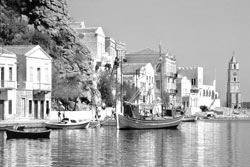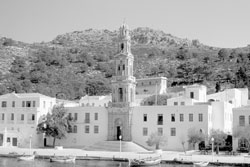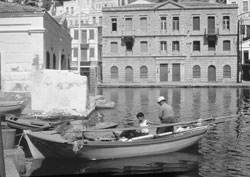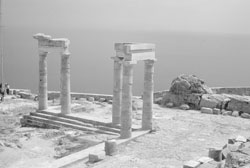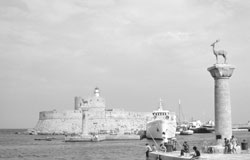Past & present: Rhodes and Symi, Greece
by Ed Kinney
The first trip Moreen and I took to the Dodecanese Islands area of the Mediterranean was in 1974. Sadly, then, as today, travelers were being advised to be cautious due to the ongoing hostilities between Greece and Turkey re the island of Cyprus.
Its macabre, but we’ve found that the optimum time to travel is during such periods as there are fewer competing tourists.
This trip to Rhodes and Symi began our lifelong interest in the Mediterranean and Middle East, where we’ve been fortunate to experience the area’s diverse cultures and have met now-lifelong friends as well as passing acquaintances who assisted a naive pair seeking education and adventure.
The island of Rhodes
In October 1974 we sailed to Rhodes, the largest island in the Dodecanese group, from Piraeus, Greece, instead of flying to that island from Athens as most do today. Cruise ships also make Rhodes a highlight stop, often overwhelming facilities.
Tourists want to see where once the Colossus of Rhodes (Helos, the sun god) stood, one of the seven wonders of the ancient world. Supposedly, it straddled the entrance to Mandraki Harbor, though it probably was built near St. John the Colossus Church in 293 B.C. and destroyed by an earthquake 66 years later. Legend also says it lay in pieces for nine centuries before its debris was hauled away on the backs of 980 camels.
Regardless of this legend, there is lots to see of this island’s recorded history, which begins in the fifth century B.C. Later, Rhodes was an important link between the Roman and Byzantine empires before the arrival of the Knights of St. John, who fought in the Crusades.
Walk through one of the 11 gates in the city’s medieval Gothic walls and visit Rhodes’ heritage in the Archaeological Museum (of Rhodes), the Palace of the Grand Masters and the Byzantine Museum.
Stroll beyond this area to where Greeks, Turks and Jews have lived for centuries among churches, mosques and synagogues. Close to the Square of the Jewish Martyrs is a 500-year-old synagogue, certainly worth investigating.
As the word “acropolis” is synonymous with Greece, travelers should also visit the two on the island of Rhodes. A short distance to the west of town stands the Acropolis of Rhodes on the site of a third-century-B.C. Hellenistic city. Our favorite is the Acropolis of Lindos, which rises above the city of Lindos, located about 50 miles down the eastern coast of the island. This acropolis has a beautiful setting within medieval walls overlooking the city of Lindos, the Mediterranean and two wonderful beaches: Grand Harbor and St. Paul’s Bay, the latter where St. Paul is reputed to have landed in A.D. 51.
The enchanting island of Symi
Travelers who like movies set in the Mediterranean will enjoy “Pascali’s Island,” starring Ben Kingsley. The movie’s opening scene blew us away. It was of a small, interisland ferry entering a lovely harbor. Though not identified, we immediately recognized this harbor to be the entrance to the island of Symi, Greece. We too had made this same sailing from Rhodes to Symi, which in our minds is one of the most beautiful islands in the Mediterranean.
The harbor town of Gialos sits as if in the front rows of an amphitheater. Beautifully painted homes instead of plain benches rise ever higher, clinging to steep hillsides overlooking a stage of boats quietly anchored in blue waters. It’s an artist’s dream.
Symi is a relatively small island, 15 miles north of Rhodes and only six miles from Turkey. Before WWI, Symi was claimed by Turkey. Then, as today, tourists arrived via water, many using the interisland Rhodes ferry to Symi. During the four hours our ferry moored along a wharf in Gialos near the old clock tower, we walked around the lower town of Gialos and its harbor area, climbed steps to the older settlement of Chorio and viewed the highest area, called Horió, crowned by Kastro Castle.
Regrettably, we didn’t have accommodations allowing us time to properly savor this pristine and, then, nearly empty paradise. Men with sons tended fishing nets or sold the day’s catch under brilliant sun. Older men huddled under the shade of bright red umbrellas in front of restaurants a few feet from water’s edge, swapping stories while sipping coffee or maybe a glass of cloudy ouzo.
Scarf-covered women carrying baskets with the night’s meal disappeared into narrow alleyways leading up into the older areas of Symi. Occasionally, a tinkling sound could be heard, long before a youngster would be seen leading an old mule laden with cases of empty bottles down these same narrow cobblestone streets to the water’s edge for their return to Rhodes on our ferry.
The scene was laid-back, yet Symi was once the third-richest island in the Dodecanese due to its harvest of (sea) sponges and the islanders’ expertise at building wooden ships. These industries are now forgotten, except in souvenirs and wooden trinkets. Today’s chief industry is tourism.
Similar to Rhodes and Lindos, Symi has also become crowded, especially during its annual music festival held in July and August. I’d avoid visiting this enchanting island then, as well as others in the Dodecanese Islands during the summer, as the magic of these islands will be masked by tourists and soaring temperatures.
Minutiae
Due to the crowds that will be attending the 2004 Summer Olympics in Greece, Aug. 13-29, I’d recommend visiting Rhodes and Symi afterward, not before. By very late September and October, temperatures should have moderated and locals won’t be as overwhelmed by the masses.
For information on Rhodes, visit http://www.ando.gr/eot/eng/islands/rodos.htm, and for Symi, www.ando.gr/eot/eng/islands.symi.htm.
As there is no airport on Symi, travel is normally limited to ferries, tourist boats and hydrofoils (fares cost €10-€20 round trip). Most tourists visit Symi only for the day, due to limited accommodations.
Some cruise ships as well as ferries also stop at Moni Taxiarhis Mihail (the Monastery of Michael of Panormítis) in Panormitis Bay. This religious site is a favorite for Greek sailors and their families, hence it is often crowded with locals.
Coming up
Next let’s visit Alexandria, Egypt, and the site of the Pharos Lighthouse, another of the Seven Wonders of the Ancient World.

